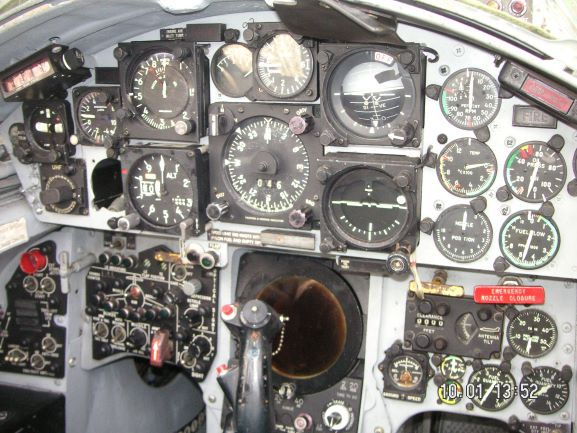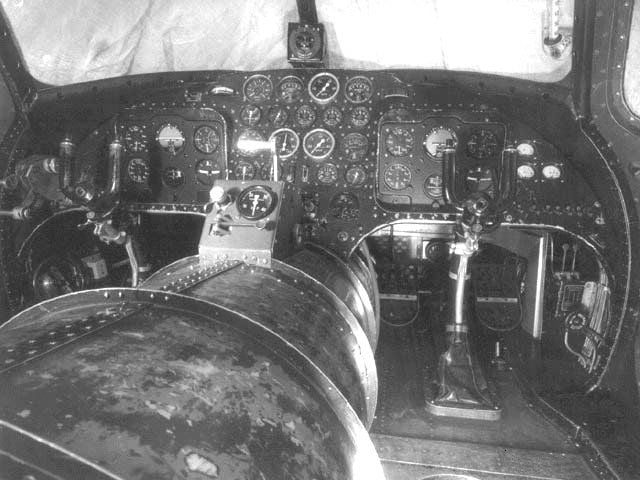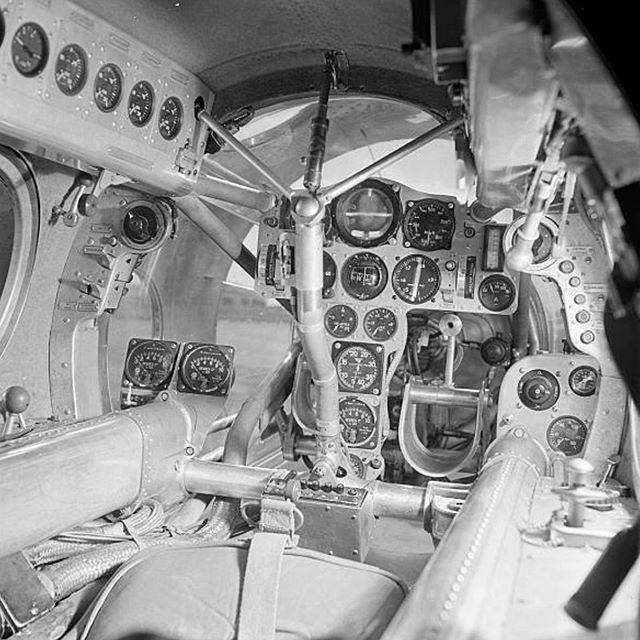What Cockpit?
I think in the circumstances we should let Dixi have another try....................
No problem
From the silhouette of the bomb display:
T-tail
Short wings sloping down
confirmed by searching
Emergency nozzle closure
F-104 Starfighter
When I followed a Management course I got some lessons on planning. The teacher/professor had been involved in a planning problem at Fokker building the Starfighters in license.
They could not get the aircraft from the pre-delivery flight test stations, so holding up delivery.
It seemed that after each test flight the amount of problems got bigger instead of smaller.
After analysis of the various problems they split the pre-flight stations in Radar repair and all other repair.
They first made an aircraft completely ready and did a test flight without radar. Then they went to a radar repair bay where they fixed the radar ASAP before something other broke down again. Time between failure of the radar was 10 hours after delivery I believe, but stand to be corrected.
From the silhouette of the bomb display:
T-tail
Short wings sloping down
confirmed by searching
Emergency nozzle closure
F-104 Starfighter
When I followed a Management course I got some lessons on planning. The teacher/professor had been involved in a planning problem at Fokker building the Starfighters in license.
They could not get the aircraft from the pre-delivery flight test stations, so holding up delivery.
It seemed that after each test flight the amount of problems got bigger instead of smaller.
After analysis of the various problems they split the pre-flight stations in Radar repair and all other repair.
They first made an aircraft completely ready and did a test flight without radar. Then they went to a radar repair bay where they fixed the radar ASAP before something other broke down again. Time between failure of the radar was 10 hours after delivery I believe, but stand to be corrected.
Last edited by Self loading bear; 2nd Feb 2020 at 20:26.
I've seen this before somewhere - it was experimental and I think it may have been French........ but what the big tube was for is beyond me ................. maybe a duct for a jet engine?? 

Thread Starter
Join Date: Aug 2006
Location: Timbukthree
Posts: 13
Likes: 0
Received 0 Likes
on
0 Posts
SUD OUEST Triton SO.6000J, first airframe designed with nose intake for French designed engine, later powered by a Junkers Jumo engine. Final version powered by RR (Hispano-Suiza built) Nene.


Last edited by evansb; 3rd Feb 2020 at 23:10.
That's the one!
https://www.militaryfactory.com/airc...rcraft_id=1237
The SO 6000 was being designed as early as 1943 in secret within German-occupied France. The initial approach called for a stressed metal skin monoplane aircraft powered by a single turbojet engine. The turbojet was to be aspirated by a wide-mouth air intake arrangement at the front of the aircraft. Unlike other jet aircraft of the early post-war years, the French design offered two interesting design qualities - its engine was buried within the fuselage (as opposed to underslung nacelles) and a crew of two were seated in a side-by-side arrangement. A tricycle undercarriage was also worked into the airframe and ejection seats were planned.The resulting design was a clean, if unorthodox, first entry into the world of jet-powered flight.
The side-by-side seating required a wide fuselage and this gave the aircraft an appearance akin to a modern corporate jet. The wide-mouth intake was replaced with two small side intakes. The fuselage shape was well-rounded and tapered noticeably from nose to tail. The low monoplane wing appendages were straight with rounded tips. Similarly, the tailplanes followed with a rounded look to them and complemented a single vertical tailfin. The tricycle undercarriage was made up of three legs (two main, one nose) and each sported a single wheel - the main legs retracting under the wings.
Attempting to recover lost technical ground from the war, French officials were sold on the promising Sud-Ouest endeavor and quickly moved to order six prototypes (one to serve in the static test role). Development of a French-originated turbojet proved slower than anticipated so this led to the selection of the rather unreliable German Junkers Jumo 004B to power the aircraft. These engines were built during the war on French soil so the decision was sound to help the SO 6000 project along. It also powered the famous wartime Messerschmitt Me 262 "Schwalbe" jet fighter.
The use of the Junkers engine produced the "SO 6000J" designation and would power the first two prototypes
First flight of the Triton was recorded on November 11th, 1946, marking a major stepping stone for French aviation. The flight lasted roughly 10 minutes and the aircraft managed a speed of only 180 miles per hour but progress was progress. The Triton then garnered considerable interest as a static display during the 1946 Paris Air Exhibit and much was expected from this impressive-looking French product going forward. Some delays brought on by technical challenges brought the program to a standstill flying-wise but the aircraft went airborne against to net a maximum speed of 250 miles per hour.
Three subsequent prototypes were initially selected to receive the British Rolls-Royce "Derwent" turbojet engine but this was not to be (the pairing generated the designation of "SO 6000N" as a result). Instead, the Rolls-Royce "Nene" 101 series turbojet engine (4,8501b thrust), already being produced locally under license for French de Havilland Vampires (through Hispano-Suiza), was set aside to also serve the Triton program. First flight of a Nene-powered SO 6000 (Prototype 04) was on March 19th, 1949 and further testing clocked the airframe at 555 miles per hour.
The Triton continued in testing for years later and went on to serve in its intended role as trainer for an all-new generation of French aviator - the jet fighter pilot. The platform proved valuable in introducing airmen to the nuances and speeds at which jet-powered aircraft operated, particularly when compared to even the fastest prop-powered fighters they were use to. While not a stunning technological achievement when compared to advances seen in Britain and the United States, the SO 6000 Triton still served French aviation well - particularly into the 1950s and 1960s with the Soviet Union now replacing Nazi Germany as the world's global threat.
All six SO 6000 aircraft were completed. Prototype 01 was the first French aircraft to fly under jet power but ended its career with just eight flights to its record before ultimately being retired in 1947. Prototype 02 was never flown as it awaited the original French turbojet engine that was not to be. Prototype 03 installed a powered ejection seat (unlike the first two prototypes) but only flew twice. Prototype 04 managed the most influential flying career of them all when it accounted for 189 flights. Prototype 05 was flown just eight times before being retired and Prototype 06 never advanced beyond its intended static testbed role.
Prototype 03 survives today as a protected museum showpiece at the Musee de 'IAir et de l'Espace of Le Bourget Airport in Paris. The Triton managed to reach a maximum speed of 593 miles per hour during its flying life as well as a service ceiling of 39,375 feet.









